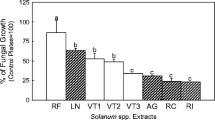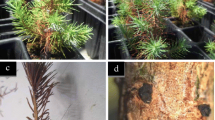Abstract
An ethanolic leaf extract of Glycyrrhiza glabra L. (licorice) was highly effective in former bioassays and semi-commercial trials in controlling cucumber downy mildew (efficacy up to 99.0 % in bioassays and 83.0 % in semi-commercial trials). In order to elucidate the active ingredients and the mode of action, licorice leaf extract was fractionated into six fractions of defined substance classes, of which the fraction containing acidic substances (F6) showed highest efficacy (97.6 %). The calculated EC50 values after a probit analysis of concentration series of crude extract and fraction F6 were concentrations of 1.0 % (crude extract) and 0.6 % (fraction F6). Interestingly, the slopes of the resulting graphs were significantly different, pointing to different modes of action for the two treatments. Three flavonoid compounds could be detected. The substances were glabranin, licoflavanon and pinocembrin. All three are known for their antimicrobial and antifungal capacity against plant and human pathogens. Besides these flavonoids, results, such as the different EC50 values, indicated that other compounds may be involved in the activity of fraction F6 against P. cubensis on cucumber.





Similar content being viewed by others
References
Bliss, C. I. (1939). The toxicity of poisons applied jointly. Annals of Applied Biology, 26, 585–615.
Curreli, F., Friedman-Kien, A. E., & Flore, O. (2005). Glycyrrhizic acid alters Kaposi sarcoma–associated herpesvirus latency, triggering p53-mediated apoptosis in transformed B lymphocytes. Journal of Clinical Investigation, 115, 642–652.
Fatima, A., Gupta, V. K., Luqman, S., Negi, A. S., Kumar, J. K., Shanker, K., Saikia, D., Srivastava, S., Darokar, M. P., & Khanuja, S. P. S. (2009). Antifungal activity of Glycyrrhiza glabra extracts and its active constituent Glabridin. Phytotherapy Research, 23, 1190–1193.
Fukui, H., Goto, K., & Tabata, M. (1988). Two antimicrobial flavanones from the leaves of Glycyrrhiza glabra. Chemical & Pharmaceutical Bulletin, 36, 4174–4176.
Haggag, W. M. (2002). Control of downy mildew on protected cucumber plants with film forming antitranspirants. Online Journal of Biological Sciences, 2, 403–407.
Hayashi, H., Hiraoka, N., Ikeshiro, Y., & Yamamoto, H. (1996). Organ specific localization of flavonoids in Glycyrrhiza glabra L. Plant Science, 116, 233–238.
Hayashi, H., Yasuma, M., Hiraoka, N., Ikeshiro, Y., Yamamoto, H., Yesilada, E., Sezik, E., Honda, G., & Tabata, M. (1996). Flavonoid variation in the leaves of Glycyrrhiza glabra. Phytochemistry, 42, 701–704.
Hayashi, H., Hattori, S., Inoue, K., Sarsenbaev, K., Ito, M., & Honda, G. (2003). Field survey of Glycyrrhiza in central Asia (1). Characterization of G. uralensis, G. glabra and the putative intermediate collected in Kazakhstan. Biological & Pharmaceutical Bulletin, 26, 867–871.
Hummelbrunner, L. A., & Isman, M. B. (2001). Acute, sublethal, antifeedant, and synergistic effects of monoterpenoid essential oil compounds on the tobacco cutworm, Spodoptera litura (Lep. Noctuidae). Journal of Agricultural and Food Chemistry, 49, 715–720.
Konstantinidou-Doltsinis, S. & Markellou, E. (2008). Antifungal activity of ethanolic Glycyrrhiza glabra L. extracts against infection of tomato plants by Phytophthora infestans. Summaries of papers and posters presented at the 14th Hellenic Phytopathological Congress, Nafplio, Greece, October 7–10
Krausse, R., Bielenberg, J., Blaschek, W., & Ullmann, U. (2004). In vitro anti-Helicobacter pylori activity of Extractum liquiritiae, glycyrrhizin and its metabolites. Journal of Antimicrobial Chemotherapy, 54, 243–246.
Lester, A., Mitscher, G. S., Rao, R., Khanna, I., Veysoglu, T., & Drake, S. (1983). Antimicrobial agents from higher plants: prenylated falvonoids and other phenols from Glycyrrhiza lepidota. Phytochemistry, 22, 573–516.
Manfredi, K. P., Vallurupalli, V., Demidova, M., Kindscher, K., & Pannell, L. K. (2001). Isolation of an anti-HIV diprenylated bibenzyl from Glycyrrhiza lepidota. Phytochemistry, 58, 153–157.
Scherf, A., Schuster, C., Marx, P., Gärber, U., Konstantinidou-Doltsinis, S., & Schmitt, A. (2010). Control of downy mildew (Pseudoperonospora cubensis) of greenhouse grown cucumbers with alternative biological agents. Communications in Agricultural and Applied Biololgical Sciences, 75, 541–555.
Schuster, C., Konstantinidou-Doltsinis, S., & Schmitt, A. (2010). Glycyrrhiza glabra extract protects plants against important phytopathogenic fungi. Communications in Agricultural and Applied Biololgical Sciences, 75, 531–540.
Seeram, N. P., Lynn, S., Adams, L. S., Hardy, M. L., & Heber, D. (2004). Total cranberry extract versus its phytochemical constituents: antiproliferative and synergistic effects against human tumor cell lines. Journal of Agricultural and Food Chemistry, 52, 2512–2517.
Shain, L., & Miller, J. B. (1982). Pinocembrin: an antifungal compound secreted by leaf glands of eastern cottonwood. Phytopathology, 72, 877–880.
Treutwein, J., Cergel, S., Runte, J., Nowak, A., Konstantinidou-Doltsinis, S., Kleeberg, H., & Schmitt, A. (2010). Wirkung von Extraktfraktionen von Glycyrrhiza glabra gegen phytopathogene Pilze. Deutsche Pflanzenschutztagung, 06.-09.09.10, Berlin: Julius Kühn-Institut, Bundesforschungsinstitut für Kulturpflanzen, Julius-Kühn-Archiv, 428, 83
Urban, J., & Lebeda, A. (2007). Variation of fungicide resistance in Czech populations of Pseudoperonospora cubensis. Journal of Phytopathology, 155, 143–151.
Acknowledgements
The authors cordially thank Julia Bahlo for in vitro and in vivo testing at Trifolio-M and Karin Bald for technical assistance at JKI. Prof. Dr. Cornelia Ullrich-Eberius and Prof. Dr. Gerhard Thiel are thanked for discussion of data and advice. Dr. Andreas Schmitt is thanked for electronical reworking of graphs. The financial support of the project by the German Federal Ministry of Food, Agriculture and Consumer Protection (BMELV) (Federal Scheme for Organic Farming project 08OE188), and the Eurostars programme (powered by EUREKA and the European Community, project E!4428-Greenprotection; national funding through the German Federal Ministry of Education and Research (BMBF), project 01QE0820) is gratefully acknowledged.
Author information
Authors and Affiliations
Corresponding author
Rights and permissions
About this article
Cite this article
Scherf, A., Treutwein, J., Kleeberg, H. et al. Efficacy of leaf extract fractions of Glycyrrhiza glabra L. against downy mildew of cucumber (Pseudoperonospora cubensis). Eur J Plant Pathol 134, 755–762 (2012). https://doi.org/10.1007/s10658-012-0051-0
Accepted:
Published:
Issue Date:
DOI: https://doi.org/10.1007/s10658-012-0051-0




